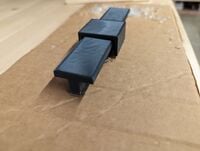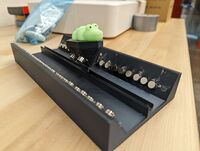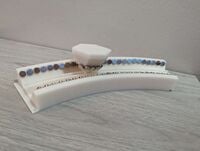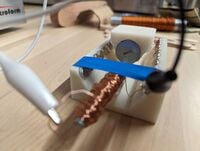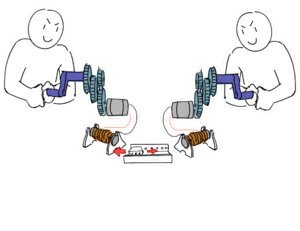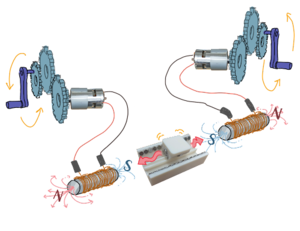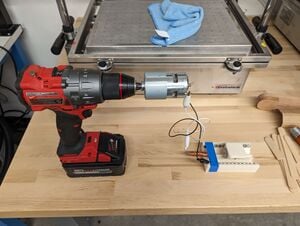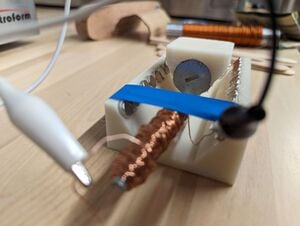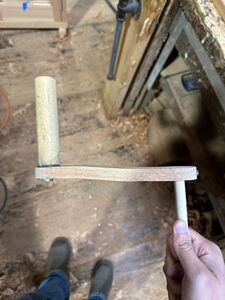Humboldt Makerspace magnetic tug of war

This project is a concept for a magnetic tug o' war game involving human-powered electromagnets and a car on a track. It was designed by a team from Cal Poly Humboldt's ENGR 205 class in Fall 2023, with the goal of creating a tabletop attraction for the School of Engineering to inspire and educate incoming students about engineering concepts.
Background[edit | edit source]
The prompt for this project was to create an attractive, interactive tabletop display for the School of Engineering for promotional and educational purposes. The client was Dr. Eileen Cashman, the department chair, and representative Alison Hodges. The students involved in working on this project went by the team name "the Audacious", to reference the unreasonably ambitious ideas that appeared in the initial brainstorming. This project took place over approximately one semester, in Fall 2023, within Cal Poly Humboldt's ENGR 205 class.
Problem statement[edit | edit source]
The objective of this project is to provide the School of Engineering at Cal Poly Humboldt with tabletop displays to educate incoming students about the different engineering disciplines at Cal Poly Humboldt and how they are involved in engineering design, and inspire interest in engineering concepts and science.
Criteria[edit | edit source]
| Criteria | Description | Weight (1-10) |
|---|---|---|
| Safety | Must consist of safe materials, as well as be reasonably safe for all ages to interact with in various ways. The design of the product must not increase the risk of harm for the persons transporting it. | 10 |
| Interactivity | Product should draw attention and promote interaction from the target audience(s). | 9 |
| Inspirational + Educational Value | Most of the target must leave with more interest and knowledge in engineering than when they came in. | 9 |
| Transporation | Must be easy to transport | 9 |
| Longevity + Repairability | Must last at least 3 years of seasonal use. Must be able to withstand a variety of conditions with limited damage.
Majority of parts must be easily replaced. |
7 |
| Cost | Must not exceed a total of $300 | 6 |
Prototyping[edit | edit source]
The goal the team had agreed on was to implement electromagnetism and interactive parts to create some sort of tabletop toy to promote interactivity. Originally, the intention was to create a hand-powered model Mag Lev (magnetic levitation) train. However, safety constraints meant that the use of liquid nitrogen to create a superconductor would not be a viable option. Instead, the team attempted to create a toy train that could still model the concepts of permanent magnetic forces and electromagnetism.
Refer to figure V1 Prototype #1 and 2 for the first functional version of the Mag Lev prototype. The bracket shaped car and I-beam track did not leave enough room for the audience to visually recognize the magnetic forces in action, even if it could be felt by hand.
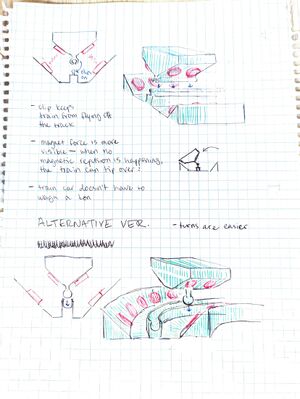
Refer to figure V2 Prototype Concept Drawings for the concept drawings of the second functional version of the Mag Lev prototype. The problems from the previous version that this new prototype hopes to improve were the visibility issue for the magnetic forces, as well as preemptively solve issues that had been identified with turning corners on the train track. Some testing for a parallel circuit of electromagnets was also involved at this stage, as shown [here].
Refer to figure V2 Prototype #1 and 2. When implementing this prototype, some problems regarding the strength of the peg on the bottom of the car arose, and two were broken at different points during the construction of these tests.
Refer to figure V3 Prototype #1. Very near the end of the semester, a fairly large pivot had to be made to accommodate time constraints and issues surrounding the strength of the electromagnets and methods of propelling the train car forward. Now, the track had been shortened to 4.5 in, and the car was adjusted to improve the strength of the bottom peg. The new goal was to create a magnetic tug o' war out of the single car on the shorter track, electromagnets, and hand-powered generators made out of DC motors.
- Prototypes
-
V1 Prototype #1 of T-shaped Model Maglev Train
-
V1 Prototype #2 of T-shaped Model Maglev Train
-
V2 Prototype #1 of 3D printed track+car
-
V2 Prototype #2 of 3D printed track+car
-
V3 Prototype #1 of Magnetic Tug O' War
Final product[edit | edit source]
The final product of this project is Tug O' War, as well as some visual aid to be displayed next to the product on the table to explain the physics and engineering concepts involved in the game.
- Final Product
-
Animation of how Magnetic Tug O' War is supposed to work
-
Tug O' War Proof of Concept Drawing
Construction[edit | edit source]
There is a hand crank that will be turned by people. This crank turns two sets of gears, where the larger gear is connected to the hand crank with a 50-toothed gear that turns a smaller 5-toothed gear. On the same axel, another 50 toothed gear is attached. This 50-toothed gear will then turn the last 5-toothed gear that then turns a DC motor for a 5000-rpm output with a 50rpm input, thus making enough power for the electromagnet.
This construction is repeated on the other side of the design.
- Construction of Tug O' War Game
-
Tug O' War Proof of Concept
-
Tug O' War Closeup
-
Hand crank that generates electromagnetic power
Bill of materials[edit | edit source]
The table below is a reflection of our team's implementation costs.
| Item | Amount | Cost per unit | Total |
|---|---|---|---|
| Track — in cm^3 ABS | 95.8 | USD 0.12 | USD 11.50 |
| Car — in cm^3 ABS | 27.9 | USD 0.12 | USD 3.35 |
| Magnets — in units | 35 | USD 0.30 | USD 10.50 |
| Copper Wire — in spools | 0.5 | USD 27.00 | USD 13.50 |
| DC Motor — in units | 1 | USD 25.00 | USD 25.00 |
| Grand total | USD 63.844EUR 54.91 <br />GBP 46.61 <br />CAD 79.17 <br />MXN 1,331.15 <br />INR 4,778.72 <br /> | ||
Operation[edit | edit source]
Maintenance[edit | edit source]
- The project yearly maintenance cost is $6.50
- Files for the 3D parts are provided for the client
- Depending on the environment of the storage space, some periodic upkeep for the hand crank may be required.
- The client should submit a maintenance request to the Humboldt Makerspace with the given implementation costs.
Maintenance schedule[edit | edit source]
- Daily
- Lubricate rail before use
- Weekly
- Lubricate rail before use
- Monthly
- Change gears if needed
- Yearly
- Continue to lubricate before use
- Continue to change gears if needed
- Every 2 years
- Replace DC Motor
Conclusion[edit | edit source]
Testing results[edit | edit source]
There has not yet been a wholly successful test of the new pivot. Instead, the focus is on the proof of concept, with the hope that the information here will be of use in improving the design in the future.
Discussion[edit | edit source]
Refer back to Construction and Operations sections.
Lessons learned[edit | edit source]
- The values of organization.
- How electromagnetism works
- Communication
Next steps[edit | edit source]
The concepts involved in this project have the potential to be useful for a variety of other situations-- such as replacing large, heavy breaker switches to create a better method of safeguarding electrical systems, or perhaps rapid-open doors or gates. The next steps for this particular implementation ought to be improving upon and refining the concept, as well as improving the aesthetics of the casing and other parts where possible.
Troubleshooting[edit | edit source]
| Problem | Suggestion |
|---|---|
| DC Motor Malfunction | Contact Makerspace coodinator |
| Rail is malfunctioning | Lubricate it |
Team[edit | edit source]
The Audacious team of Fall 2023 consisted of the following students:
- Jahni Caldwell
- Paloma Rall
- Ian Berry
- Madcen Murillo-Suvia
References[edit | edit source]

